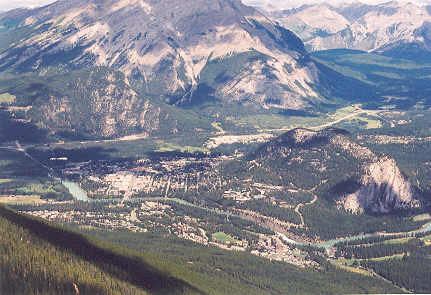Elevation 1,692 m (5,551 ft) | Prominence 305 m (1,001 ft) Topo map NTS 82O/04 | |
 | ||
Parent range South Banff Ranges, Canadian Rockies | ||
Tunnel Mountain is a mountain located in the Bow River Valley of Banff National Park in Alberta, Canada. The mountain is nearly completely encircled by the town of Banff and the Banff Springs Hotel grounds.
Contents
History
The Stoney people had long called the mountain "Sleeping Buffalo", as it resembles a sleeping buffalo when viewed from the north and east. In 1858, James Hector named the small peak "The Hill", likely in reference to its status as the smallest peak adjacent to the Banff townsite.
In 1882, a team of surveyors led by Major A.B. Rogers, of Rogers Pass fame, was surveying for the construction of the Canadian Pacific Railway. Rogers, likely in a hurry, assumed the easiest path for the railway to take would be to simply follow the Bow River. On account of the difficulties that would be faced with river crossings and the steepness of the cliffs between the northwestern edge of Mount Rundle and Tunnel Mountain, Rogers' team suggested the construction of a 275 m (902 ft) tunnel through the tiny mountain. CPR General Manager William Cornelius Van Horne was furious at the suggestion, exclaiming "Are we going to hold up this railway for a year and a half while they build their damned tunnel? Take it out!" An alternative route north of the mountain was found, which incidentally shortened the railway by a mile, and avoided two long hills, saving the CPR millions of dollars. Surveyor Charles Shaw described the idea as "the most extraordinary blunder I have ever known in the way of engineering." The idea of a tunnel was scrapped altogether, but the mountain is still called Tunnel Mountain to this day.
King George VI and Queen Elizabeth hiked to the top of the mountain during their 1939 Royal Tour. The fire lookout on top of the mountain began to be known as "King's Lookout," though it is not extant.
Hiking
Tunnel Mountain, likely due to its easy grade and location in the heart of Banff, is a very popular hike. The trail has a gentle grade for most of the way, with a few mildly steep sections, and is only 4.3 km (3 mi) round-trip. The top offers a panoramic view of the townsite, the Bow valley and the surrounding wilderness, and many recommend it as an easy introductory hike to the area.
The mountain has also drawn praise from many famous mountaineers. James Outram, the first person to climb Mount Assiniboine climbed Tunnel in 1900, commenting "the view will never be forgotten." Arthur O. Wheeler, co-founder of the Alpine Club of Canada also praised the view:
Perhaps the most devout admirer of the mountain was Anne Ness, a local resident. Anne climbed Tunnel Mountain over 8000 times over a 40-year period, averaging 200 ascents a year. Ness was even known to climb the mountain twice a day; once during lulls in her job, and a second in the evening. Famed wildlife artist Carl Rungius had his ashes scattered on the mountain, as he loved the view of Banff and the Bow Valley.
Geology
Tunnel Mountain gives its name to the Tunnel Mountain Formation, a geological formation.
